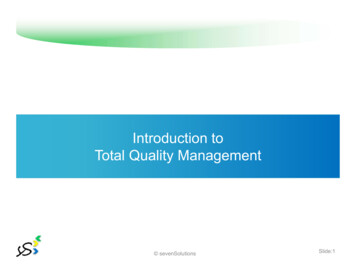
Transcription
Proceedings of the International Conference on Industrial Engineering and Operations ManagementBogota, Colombia, October 25-26, 2017The Role of Total Quality Management (TQM) Practices onImproving Organisational Performance in Manufacturingand Service Organisations.Nita SukdeoDepartment of Quality and Operations ManagementUniversity of JohannesburgGauteng, South Africa2001nsukdeo@uj.ac.zaJan-Harm Pretorius and Andre VermeulenSchool of Engineering ManagementUniversity of JohannesburgGauteng, South Africa2001AbstractOrganisations in South Africa now, more than ever before, need to introduce Total Quality Management(TQM) in their organisational culture to provide outstanding products and services to their customers.Although TQM has been introduced to improve organisational performance, it is perceived that someorganisations have not accomplished much over the years. Achieving results by implementing TQM ischallenging and depends on (i) leadership, (ii) employee involvement, (iii) customer focus, (iv) strategicplanning, (v) supplier relations, (vi) process management and (vii) information analysis. These principlesmust be incorporated in the organisational performance measures in terms of (i) quality improvement, (ii)product/service quality, (iii) customer satisfaction, (iv) employee satisfaction and (v) supplier performance.Current research in both the manufacturing and service industries in South Africa reveals that TQM doeshave an influence on the five organisational performance measures and plays an important role in theperformance and success of an organisation.KeywordsTotal quality management, organisational performance, performance measure, customer satisfaction1. IntroductionThe impact of global competition is forcing organisations to place greater emphasis on providing customers with highquality products and services [Baloyi, 2013] [Dale, 1999] [Edosmwan, 2002]. Consequently, improving the quality ofproducts, processes and services is a major challenge facing South African organisations as well as organisationsworldwide. Many organisations fail because they do not take cognisance of the long-term benefits of Total QualityManagement (TQM) practices. Organisations do not realise the value of integrating these practices into their vebeendevelopedforthestudy:a)To design and administer a questionnaire to determine the role and impact of quality improvement, customersatisfaction, employee satisfaction, product/service quality and supplier performance in the manufacturingand service organisations, which lead to organisational performance.b) To determine the relationship between TQM practices and organisational performance by means ofhypothesis testing. IEOM Society International1133
Proceedings of the International Conference on Industrial Engineering and Operations ManagementBogota, Colombia, October 25-26, 2017In line with objective b) the following hypotheses were developed:H1:H2:H3:H4:H5:The TQM practices are positively related to quality improvement.The TQM practices are positively related to product/service quality.The TQM practices are positively related to customer satisfaction.The TQM practices are positively related to employee satisfaction.The TQM practices are positively related to supplier performance.2. Literature reviewQuality is extremely advantageous for every organisation today. Quality plays a significant role in the businessenvironment of organisations as quality and continuous quality development guarantee an organisation s survival ina competitive environment. [Evans, 2005] [Foster, 2007]. A plethora of studies have been undertaken on the role ofTQM practices in enhancing organisational performance in both manufacturing and service organisations. Somestudies were undertaken in specific industries whilst others were comparative in nature. Brief reviews of some of thestudies are presented below and selected TQM practices are highlighted.2.1 Implementation of TQM in global organisationsChin, Tummala and Chan (2003) conducted a survey of the implementation of TQM practices in the Hong Kongelectronics and toy product organisations. These organisations were required to indicate the extent to which TQMpractices were being implemented and practiced. The five TQM practices used in their study were (i) customer focus,(ii) leadership, (iii) strategic planning, (iv) activity based management and (v) continuous improvement. Their studyestablished that both Hong Kong industries regarded customer focus as the most important TQM practice. Mady(2009) conducted a survey of the implementation of TQM in two Kuwaiti industrial sectors, namely food processingand refractors. The TQM practices of (i) customer focus, (ii) employee involvement and (iii) core quality practiceswere used in their study. He found that these three TQM practices were used in both industries to improve quality.Arumugam, Ooi and Fong (2008) explored the relationship between TQM practices and organisational performancein Malaysian manufacturing organisations. The TQM practices identified in their study were (i) leadership, (ii) processmanagement, (iii) information analysis, (iv) customer focus, (v) supplier relations, (vi) quality system improvement,(vii) continual improvement and (viii) employee involvement. They found that a positive relationship existed betweencustomer focus and organisational performance.2.2 Implementation of TQM in South African organisationsOschman, Stroh and Auriacombe (2006) studied the attitude of personnel at South African Air Force bases towardsthe implementation of TQM. They developed a framework consisting of six core practices and eight supportingpractices. They found that the attitude of respondents in three out of the six core practices (leadership, employeeinvolvement and strategic planning) was very positive with respect to quality improvements. With regard to themanufacturing sector, [Baloyi, 2013] [Tashakkori and Creswell, 2007] [Ceronio, 1996], identified the following TQMpractices as imperative to the implementation and success of TQM in manufacturing industries: (i) top managementcommitment and (ii) communication, (iii) employee involvement through training, (iv) quality strategy, (v) productquality and (vi) customer satisfaction. He highlighted these practices as critical factors to enhancing organisationalperformance.2.3 Implementation of TQM in manufacturing and service industriesIn today’s competitive business environment TQM has experienced a fundamental shift. The theory is no longerrestricted to the manufacturing sector. It has now been extended to service sectors such as health care, education,hospitality and financial institutions, to name a few [Lakhe and Mohanty, 1995]. It has been identified andacknowledged the applicability of TQM for sustainable competitive advantage and especially highlighted its value forthe service sector. The growth of the service industry has resulted in an increased focus on TQM in serviceorganisations delivering high-quality services to customers [Schneider and White, 2004] and [Talib, Rehman andQureshi, 2013]. According to Gustafsson, A, Nilsson and Johnson (2003), studies were undertaken in themanufacturing sector and later spread to the service sector. Therefore, the study has endeavoured to include the serviceenvironment and draw a comparison with the manufacturing environment.3. Research FrameworkThe following research framework was followed. Studies were conducted using empirical hypotheses to test specific IEOM Society International1134
Proceedings of the International Conference on Industrial Engineering and Operations ManagementBogota, Colombia, October 25-26, 2017TQM practices such as leadership (top management commitment), employee involvement (human resourcemanagement) or customer focus, to determine their effect on organisational performance. Other practices that wereidentified are: supplier relations, strategic planning, process management and information analysis [Taylor andWright, 2006]. A discussion on the evaluation of the importance of each of these practices and their success as driversof TQM are illustrated in Figure 1.TOTAL QUALITY MANAGEMENT PRACTICES:1.2.3.4.5.6.7.LeadershipEmployee involvementCustomer focusStrategic planningProcess managementSupplier relationsInformation analysisORGANISATIONAL PERFORMANCE MEASURES:1.2.3.4.5.Quality improvementProduct/service qualityCustomer satisfactionEmployee satisfactionSupplier performanceOVERALL ORGANISTIONAL PERFORMANCEFigure. 1 – Research framework3.1 LeadershipGonzalea and Guillen (2002) agreed that “management commitment and leadership” is one of the most importantfactors for the successful implementation of TQM. Leadership had to create and maintain an environment that requiredthe involvement of all employees to achieve the quality objectives of the organisation. Furthermore, leadershipgenerates a trustworthy environment that is to influence employees to operate beyond formal power and bring aboutintense changes. Therefore, the quality improvement process begins with leadership’s commitment to qualityinitiatives [Kachru, 2007] [Lakshman, 2006]. This in turn leads to the higher level of involvement by employees inthe organisation and their contribution to quality initiatives.3.2 Employee InvolvementEmployee involvement is a process designed to empower members of an organisation to make decisions and to solveproblems appropriate to their level in the organisation. The importance of employee involvement in the organisationis well established in TQM. Employee involvement can take a variety of forms such as job participation, teamwork,employee empowerment, training and development, to name a few [Spector, 1997]. Employee involvement isregarded as the most important ingredient to achieve quality commitment and results. This means that every employeein an organisation is involved in the quality improvement of products and processes [Edosmwan, 2002]. In addition,employee training, resource allocation, employee empowerment, quality awareness and employee recognition havebeen identified as important dimensions of employee involvement [Abdullah, Uli and Tari, 2008] [Gryna, Chua andDeFoe, 2001].3.3 Customer FocusQuality specialists such as Deming, Juran and Crosby, have recognised customer focus as the key to continuous qualityimprovement in organisations. In their comprehensive review of literature, reports that customer focus had received IEOM Society International1135
Proceedings of the International Conference on Industrial Engineering and Operations ManagementBogota, Colombia, October 25-26, 2017the widest coverage. The importance of customer focus is the principal point of any quality initiative. The goal ofsatisfying customers is fundamental to TQM, and the goal could be achieved by an organisation’s attempt to designand deliver products and services that fulfil customer needs [Cai, 2009] [Soderquist, Chanaran and Motwani, 1997].Customer focus is critical to TQM since it is the customer who dictates the level of quality they want to receive. Thismeans that organisations have to listen to their customers, collect information from their customers and, by analysingthis information, determine the needs and expectations of customers [Jablonski, 1992] [Ooi, Lui, Hung and Yen,2010].3.4 Supplier RelationsThe supplier relationship is the supply chain process that provides the structure for managing relations with suppliers.The supplier relationship is the discipline of strategically planning for, and managing, all interactions with third partyorganisations that supply goods and/or services to an organisation in order to maximize the value of those interactions[Chip, Reinecker and Spiller, 2004]. A competitive business environment puts pressure on organisations to improvequality, deliver performance and be responsive while continuing to reduce costs. For some organisations this meansreducing the supplier base and developing closer relationships with remaining suppliers [Park, Shin, Chong and Park,2010] [Sanders, Murph and Eng, 1980]. Fifty percent of an organisation’s non-conformances are due to defectiveincoming material and resources. The relationship between supplier and buyer is one of the most important parts ofthe quality improvement process. Therefore, organisations are now implementing Supplier Relationship Management(SRM). In this instance, long term supplier relationships with suppliers need to be established [Kannan and Tan, 2006][Leonard and Sasser, 1982] [Pande, Neumann and Cavanaugh, 2000].3.5 Strategic PlanningStrategic management is an ongoing process that assesses the market in which the organisation is involved, evaluatesits competitors and then sets goals and formulates strategies to meet all existing and potential customer needs[Treiman, 2009] [Venter, 2006]. Strategic planning is of dynamic importance in establishing TQM [Cascella, 2002].Through strategic planning, specific TQM objectives and requirements of an organisation can be determined andintegrated into a strategic plan. Strategic planning should be used to plan, develop and implement strategies that wouldresult in improved customer and employee satisfaction [Cascella, 2002] [Oschman, Stroh and Auriacombe, 2005].3.6 Process ManagementTQM is a customer-based approach. The emphasis on customer service requires an organisation to be process based.TQM relies on the belief that the overall quality of products can be enhanced by improving the quality of the processesdirectly or indirectly related to its manufacture or the service provided [Ahire, Golhar and Waller, 1996]. Processesinvolve determining what work is needed to accomplish a goal, assigning tasks to individuals and arranging thoseindividuals in an organisational structure supportive of decision-making. A properly implemented process shouldresult in a work environment where all employees execute tasks to achieve goals, both effectively and efficiently.Process management also consists of the analysis and improvement of interdisciplinary tasks within an organisation[Harrington, 1991] [Oakland 2003].3.7 Information AnalysisSimply collecting information is not enough. Organisations must ensure that information systems are accurate, userfriendly and secure, and that information is available to all who require it. The availability of such information helpsmanagers in the decision-making process [Tashakkori and Creswell, 2007]. Organisations that consistently collectand analyse information will be more successful than those that do not. One of the main challenges facingorganisation’s today, is the increasing flow of information as well as the quality of data being distributed [Lee, Ooi,Sohal and Chang, 2012].3.8 Organisational PerformanceThe successful implementation of TQM, will lead to numerous benefits such as a reduction in costs, an improvementin product or service quality, an increased market share and augmented customer satisfaction. It was identified thatcertain practices of TQM such as leadership and employee involvement were associated with improved organisationalperformance [Bricknell, 1996] [Yusof and Aspinwell, 2000]. IEOM Society International1136
Proceedings of the International Conference on Industrial Engineering and Operations ManagementBogota, Colombia, October 25-26, 20173.9 Measures of Organisational Performance3.9.1 Quality ImprovementThere is a clear relationship between quality and productivity. Productivity can be increased by simplifying theproduction process and eliminating waste [Garvin, 1987]. Gitlow, Oppenheim and Levine (2005) identified severalbenefits from improving the production process such as a reduction in rework, an increase in productivity and animprovement in the quality of products and processes. In their survey of Australian manufacturing organisations,[Mandal, Shah, Love and Li, 1999] found that 65% of these organisations achieved a reduction in rejects through theuse of statistical quality techniques. They noted that the cost of quality, inventory, scrap and rework was reducedthrough the prevention of defects rather than detection. Radovolsky, Gotcher and Slattsveen (1996) performed astatistical analysis of survey data obtained from manufacturing and service organisations using the five qualityimprovement dimensions of error/defect reduction, quality cost reduction, productivity improvement, profitability andreduction in customer complaints. Their findings indicate that the number of TQM practices that were used in thequality improvement of products and processes had a significant influence on the reduction in errors/defects and anincrease in productivity and profitability.3.9.2 Product/Service QualityThe need for understanding customer expectations is a prerequisite for delivering superior products and services,because they represent the implicit measures which customers use in assessing product and service quality. Customerpressures for cost reductions and increasing global competition based on overall product and service quality are themost important drivers of quality improvement initiatives [Sila and Ebrahimpour, 2005]. To improve product andservice quality, it is imperative to measure the existing quality of products and services in order to identify what needsimprovement [Evans, 2005] [Foster, 2007].3.9.3 Customer SatisfactionCustomer satisfaction is defined as the overall attitude of customers towards a product or service after they haveacquired and consumed/used it [Malhortra, 1999]. During and after the use of a product or service, customers willdevelop feelings of satisfaction or dissatisfaction. Satisfaction or dissatisfaction levels are a function of the differencebetween perceived performance and expectation of a product or service. It was found that the goal of satisfyingcustomers is fundamental to TQM and that this goal can be achieved by an organisation’s attempt to design and deliverproducts and services to fulfil customer needs. Therefore, TQM is a corporate state of mind that succeeds only whenthe organisation is willing to change, to make decisions based on the primary goal of satisfying customer needs[Johnson and Christensen, 2008]. TQM as a set of management practices, focusing on customer satisfaction, has beenwidely adopted by many organisations [Spector, 1997] [Vermeulen, 1996]. TQM allows organisations to achieve agreat degree of differentiation, satisfying customer needs, strengthening organisational performance and brand image[Crawford, 1990]. Managers should therefore, in their overall business processes, create initiatives and trainingprogrammes to increase customer satisfaction. Dramatic changes in the business environment have led to increasedcustomer awareness of quality.3.9.4 Employee SatisfactionEmployee satisfaction is a measure of how happy (satisfied) employees are with their job and work environment.Organisations should implement a culture that encourages and enforces employee satisfaction. Employees are moreloyal to their organisations and productive in their work when they are satisfied with their jobs. These employeesaffect customer satisfaction which leads to organisational performance [Hunter and Tietyen, 2009] [Sousa, 2003].Many organisations that have adopted TQM have seen an improvement in the attitudes, commitment and retention ofemployees. Since TQM is intended to create an environment that shows the best in each employee, it is expected toimprove employee and job satisfaction through involvement and empowerment [Karia and Asaari, 2006]. TQM holdsa set of practices which contribute to improving employee involvement, performance and satisfaction througheducation and training.3.9.5 Supplier PerformanceTQM has been the key to the globalisation of manufacturing and service industry for years. Some techniques havebeen adopted across the world, which have facilitated the supply chain of today, by raising the performance ofsuppliers. Customer satisfaction depends on supplier performance. In the past twenty years, supplier performance hasplayed a crucial role in the supply chain. This is due to suppliers being one of the major components of an IEOM Society International1137
Proceedings of the International Conference on Industrial Engineering and Operations ManagementBogota, Colombia, October 25-26, 2017organisation’s policy and procedures [Bhatt and Huq, 2002]. It was found that the will and capacity of supplierssharing information has a significant impact on their performance [Vermeulen, Pretorius, Sukdeo and Kruger, 2017)[Kannan and Tan, 2006] [Lascellas and Dale, 1989].4. Research Methodology4.1 Research InstrumentThe research instrument utilised in the study was a questionnaire, which consisted of three sections. Thefirst section identified biographical details, the second identified and measured the seven constructs of TQMpractices and the third identified and measured the five organisational performance measures. The selfadministered questionnaire was personally delivered to 90 randomly selected manufacturing and serviceorganisations. Thirteen of the organisations declined to participate due to the confidentiality of theinformation which would be obtained from the organisations. Eight questionnaires were not returned andof the 69 that were returned, 4 were discarded because they were incomplete. Therefore, the sampleconsisted of 65 respondents, which comprised 33 manufacturing organisations and 32 service organisations.5. Hypothesis Testing5.1 Independent and Dependent VariablesAn independent variable (predictor variable) is a variable that is manipulated by the researcher to determine the effectit has on another variable. The variable that is influenced by the independent variable is known as the dependentvariable (criterion or response variable) [Rao, Raghunathan and Solis, 1999]. In testing the hypotheses, theindependent variables are the TQM practices of leadership, employee involvement, customer focus, strategic planning,process management, supplier relations and information analysis. The dependent variables are the organisationalperformance measures of quality improvement, product/service quality, customer satisfaction, employee satisfactionand supplier performance. Multiple regression analysis was used to test the five hypotheses. It is a useful techniquethat can be utilised to analyse the relationship between a single dependent variable and several independent variables[Levine, Ramsay and Smidt, 2001]. The statistical analysis of data, using multiple regression analysis, proceeded asdiscussed below.5.2 Testing the Validity of the Multiple Regression ModelThe initial step in the analysis is to employ testing to determine the ability of the multiple independent variables toexplain the behaviour of a single dependent variable. The F-distribution test was applied in testing the hypothesis.The F-test indicates the usefulness of a multiple regression model in predicting a dependent variable [McClave andSincich, 2003]. More specifically, this study tested whether the independent variables of (i) leadership, (ii) employeeinvolvement, (iii) customer focus, (iv) strategic planning, (v) supplier relations, (vi) process management and (vii)information analysis, are capable of effectively estimating the effect on the dependent variables of qualityimprovement, product/service quality, customer satisfaction, employee satisfaction and supplier performance. Thecoefficient of multiple determination (R2) is used as a next step of this analysis to estimate the percentage of variationin the dependent variable that can be explained by the set of independent variables. McClave and Sincich (2003)regarded this coefficient as a statistical quantity which indicates how well the multiple regression models fit the data.They state that a value close to zero shows a weak fit whereas a value close to one shows a good fit.5.2.1The relationship between the independent variable (TQM constructs) and the dependentvariable (quality improvement)(Constant)LeadershipTable. 1 – Coefficients of dependent variable (quality improvement)StandardizedUnstandardized CoefficientsCoefficientsBStd. ErrorBetat0.1280.4260.3000.0320.1490.0290.216 IEOM Society InternationalSig.0.7650.8301138
Proceedings of the International Conference on Industrial Engineering and Operations ManagementBogota, Colombia, October 25-26, 2017Employee Involvement0.2420.1510.2371.6040.114Customer Focus0.2280.1490.2041.5290.132Supplier Relations0.0810.1320.0730.6120.543Strategic Planning0.2370.1490.2361.5960.116Process Management0.1380.1390.1370.9950.324Information Analysis-0.0100.110-0.011-0.0930.926The regression analysis in Table 1, identified the relationship between the predictors (TQM practices) and thedependent variable Quality Improvement. The contribution of the predictor variable, Information analysis was notsignificant (t - 0.093) to the variation of the dependent variable, Quality Improvement. Therefore, Information andanalysis was excluded since it did not contribute in a significance to the change in Quality Improvement. Using theinformation in Table 1, the estimated regression model is given in the following regression equation:y(QI) 0.128 0.032(x 1 ) 0.242(x 2 ) 0.228(x 3 ) 0.081(x 4 ) 0.237(x 5 ) 0.138(x 6 )whereQI Quality Improvementx i relates to each element 1, 2, 3, 4, 5, 6, 7ix 1 Leadershipx 2 Employee Involvementx 3 Customer Focusx 4 Supplier Relationsx 5 Strategic Planningx 6 Process Managementx 7 Information AnalysisThe coefficient of determination (R2) is an estimate of the percentage variation in the dependent variable (QI) whichcan be predicted from the independent variable (TQM practices). This coefficient shows how well the multipleregression model fits the data. A value close to zero shows a weak fit whereas a value close to one implies a good fit.The R2 – value of 0.607 in Table 27, indicates that 60.7% of the variation in QI can be explained by the 6 predictorvariables identified in the regression equation. The larger beta (β) coefficients are 0.242, 0.228 and 0.237,corresponding to Employee involvement, Customer focus and Strategic planning, respectively (independent variables)which means that one unit increase in Employee involvement is followed by 0.242 unit increase in QI. Similarly, theother positive beta coefficients, mean that one unit increase in either one of the beta coefficients would result in a unitincrease in QI. It is evident that Employee involvement, Customer focus and Strategic planning (t 1.604, t 1.529and t 1.596, respectively) have a significant impact on QI whereas the other elements are not as highly significant.Therefore, based on the above multiple regression analysis, the first hypothesis (H 1 ) which relates the TQM elementsto QI, is partially supported.5.2.2The relationship between the independent variable (TQM constructs) and the dependentvariable (product/service quality)Table. 2 – Coefficients of dependent variable (product/service ficientsBStd. 0.1540.1230.813Employee Involvement0.1540.1560.1630.992Customer Focus0.2670.154 IEOM Society 9
Proceedings of the International Conference on Industrial Engineering and Operations ManagementBogota, Colombia, October 25-26, 2017Supplier Relations-0.0790.136-0.078-0.5820.563Strategic Planning0.0370.1530.0400.2410.811Process Management0.0880.1430.0940.6150.541Information Analysis0.2080.1140.2461.8270.073The regression analysis Table 2, identified the relationship between the predictors (TQM elements) and the dependentvariable Product / Service Quality. The contribution of the predictor variable, Supplier Relations was not significant(t - 0.582) to the variation of the dependent variable, Product / Service Quality. Therefore, Supplier Relations wasexcluded since it did not contribute in significance to the change in Product / Service Quality. Utilising the results inTable 2, the estimated regression model is given in the following regression equation:y(PSQ) 0.748 0.125(x 1 ) 0.154(x 2 ) 0.267(x 3 ) 0.037(x 5 ) 0.088(x 6 ) 0.208(x 7 )wherePSQxi Product / Service Quality relates to each element 1, 2, 3, 4, 5, 6, 7 Leadership Employee Involvement Customer Focus Supplier Relations Strategic Planning Process Management Information Analysisix1x2x3x4x5x6x7The coefficient of determination (R2) is an estimate of the percentage variation in the dependent variable (PQS) whichcan be predicted from the independent variable (TQM elements). This coefficient shows how well the multipleregression model fits the data. A value close to zero shows a weak fit whereas a value close to one implies a good fit.The R2 – value of 0.514 in Table 2, indicates that 51.4% of the variation in PSQ can be explained by the 6 predictorvariables identified in the regression equation. The beta (β) coefficient reflected in Table 2 are the values for theregression equation for predicting the dependent variable from the independent variable. The larger beta (β)coefficient is 0.267, corresponding to Customer focus (independent variable), which means that one standarddeviation increase in Customer focus is followed by 0.267 standard deviation increase in PSQ. Similarly, the otherpositive beta coefficients corresponding to Leadership (0.125), Employee involvement (0.154), Customer focus(0.267), Strategic planning (0.037), Process management (0.088) and Information analysis (0.208), means that onestandard deviation increase in either one of the beta coefficients would result in a standard deviation increase in PSQ.It is evident that Customer Focus (t 1.737) as well as Information Analysis (t 1.827) has a slight significant impacton PSQ. Therefore, based on the above multiple regression analysis, the second hyp
3.6 Process Management . TQM is a customer-based approach. The emphasis on customer service requires an organisation to be process based. TQM relies on the belief that the overall quality of products c











